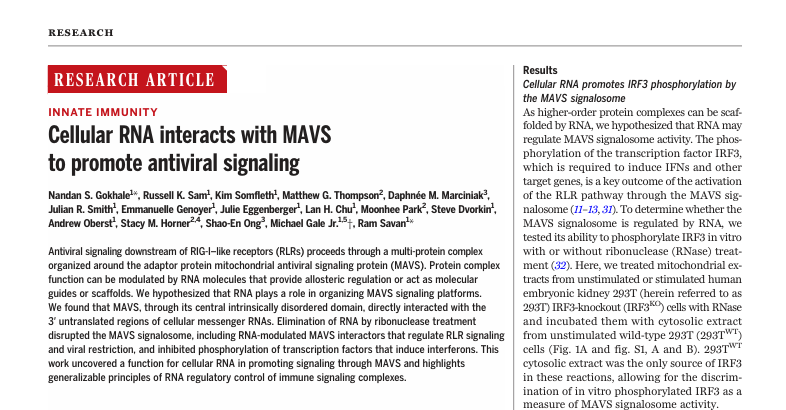胞内RNA支持抗病毒防御
RIG-I 样受体 (RLR) 是动物细胞中检测病毒 RNA 的传感器。RLR 向线粒体抗病毒信号转导接头蛋白(MAVS)发出信号,以刺激信号转导复合物的形成,从而触发转录因子和抗病毒基因程序的激活而发挥抗病毒作用。Gokhale 等人发现,MAVS 中的非结构化区域与胞内 RNA 的 3' 非翻译区相互作用,而不是与病毒 RNA直接发生相互作用,这不依赖于 RLR(参见 Best 和 Hage 的观点)。胞内 RNA 影响 MAVS 与其他蛋白质之间的相互作用。敲除以前不知道调节 MAVS 但与MAVS相互作用的几种蛋白以胞内RNA 依赖性方式抑制了 RLR 依赖性抗病毒反应。—Sarah H. Ross Science 第 1362 页,DOI:10.1126/science.adl0429 另见第 1346 页,DOI:10.1126/science.adu4928
RIG-I–like receptors (RLRs) are sensors that detect viral RNA in animal cells. RLRs signal to the mitochondrial antiviral signaling (MAVS) adaptor protein to stimulate the formation of a signaling complex that triggers the activation of transcription factors and antiviral gene programs. Gokhale et al. found that an unstructured region within MAVS interacts with the 3′ untranslated regions of cellular RNA, rather than viral RNA, and this was not dependent on RLRs (see the Perspective by Best and Hage). Cellular RNAs influenced the interaction between MAVS and other proteins. Depletion of several proteins that were not previously known to regulate MAVS, but that interacted with MAVS in a cellular RNA–dependent manner, inhibited RLR-dependent antiviral responses. —Sarah H. Ross Science p. 1362, 10.1126/science.adl0429
see also p. 1346, 10.1126/science.adu4928
